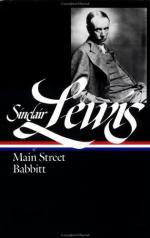The damp, yellow-brick schoolbuilding in its cindery grounds.
The State Bank, stucco masking wood.
The Farmers’ National Bank. An Ionic temple of marble. Pure, exquisite, solitary. A brass plate with “Ezra Stowbody, Pres’t.”
A score of similar shops and establishments.
Behind them and mixed with them, the houses, meek cottages or large, comfortable, soundly uninteresting symbols of prosperity.
In all the town not one building save the Ionic bank which gave pleasure to Carol’s eyes; not a dozen buildings which suggested that, in the fifty years of Gopher Prairie’s existence, the citizens had realized that it was either desirable or possible to make this, their common home, amusing or attractive.
It was not only the unsparing unapologetic ugliness and the rigid straightness which overwhelmed her. It was the planlessness, the flimsy temporariness of the buildings, their faded unpleasant colors. The street was cluttered with electric-light poles, telephone poles, gasoline pumps for motor cars, boxes of goods. Each man had built with the most valiant disregard of all the others. Between a large new “block” of two-story brick shops on one side, and the fire-brick Overland garage on the other side, was a one-story cottage turned into a millinery shop. The white temple of the Farmers’ Bank was elbowed back by a grocery of glaring yellow brick. One store-building had a patchy galvanized iron cornice; the building beside it was crowned with battlements and pyramids of brick capped with blocks of red sandstone.
She escaped from Main Street, fled home.
She wouldn’t have cared, she insisted, if the people had been comely. She had noted a young man loafing before a shop, one unwashed hand holding the cord of an awning; a middle-aged man who had a way of staring at women as though he had been married too long and too prosaically; an old farmer, solid, wholesome, but not clean—his face like a potato fresh from the earth. None of them had shaved for three days.
“If they can’t build shrines, out here on the prairie, surely there’s nothing to prevent their buying safety-razors!” she raged.
She fought herself: “I must be wrong. People do live here. It can’t be as ugly as—as I know it is! I must be wrong. But I can’t do it. I can’t go through with it.”
She came home too seriously worried for hysteria; and when she found Kennicott waiting for her, and exulting, “Have a walk? Well, like the town? Great lawns and trees, eh?” she was able to say, with a self-protective maturity new to her, “It’s very interesting.”
III
The train which brought Carol to Gopher Prairie also brought Miss Bea Sorenson.
Miss Bea was a stalwart, corn-colored, laughing young woman, and she was bored by farm-work. She desired the excitements of city-life, and the way to enjoy city-life was, she had decided, to “go get a yob as hired girl in Gopher Prairie.” She contentedly lugged her pasteboard telescope from the station to her cousin, Tina Malmquist, maid of all work in the residence of Mrs. Luke Dawson.




